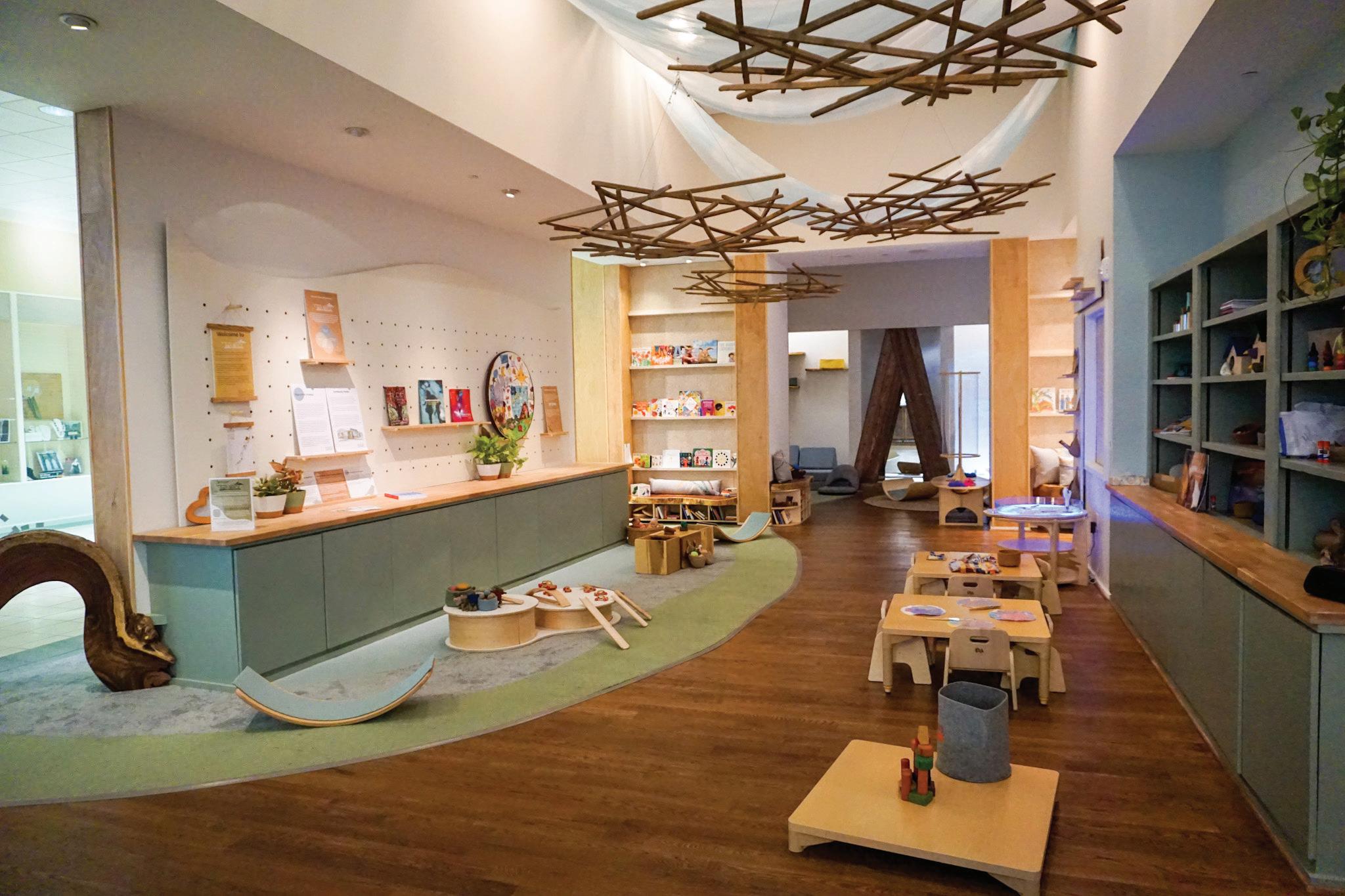
16 minute read
Design for Well-Being: Fostering Empathy, Kindness, and Connection
Melanie Hatz Levinson and Samantha Shannon, Kidzu Children’s Museum; Brad Burns, AIA, Gensler
The space is beautiful, and all of the interactive materials are wonderfully intentional. Having had a few opportunities to explore the space with my children, it has been amazing to see how calming the atmosphere is for them. My normally high-energy four-year-old was moved to quietly investigate the different areas. I was so impressed with how the toys inspired him to show empathy not only to the toys but also to the other children playing in the space. He loved snuggling with the soft crocheted birds and pushing the dolls on the swings.
Advertisement
– Nest Caregiver, August 2022
Many museums have observed more challenging behaviors and wear and tear on their exhibits and collections post-pandemic. At Kidzu Children’s Museum, in Chapel Hill, North Carolina, we have experienced the same: Our props need to be replaced at faster rates, and we are seeing more destructive behaviors to the built environment than ever before.
Our makerspace, the Makery, with its loud woodworking and tinkering, and our climbing structures have helped to direct some of the new energy, yet we are still noticing visitors coming in highly charged, and some of our environments may over-stimulate rather than soothe.
At the same time, we have found that our Reggio Emilia-inspired early learning spaces have had the opposite effect. We have seen firsthand and heard from visitors that they slow down and become more empathic to each other in these environments, helping to add longevity to exhibit elements and providing spaces conducive to socio-emotional growth and healing.
We don’t have the panacea to this postCOVID behavioral phenomenon, but we offer a case study of the Nest: the museum’s newest early learning environment for infants, toddlers, and their caregivers, that opened 2022.
Case Study: The Nest
The Nest is grounded in the Reggio Emilia philosophy, which insists that children have a right to beautiful spaces and that a physical space has the power to foster “encounters, communication, and relationships.” Crucial elements of the learning experience, the design and aesthetic of Reggio-inspired environments use natural elements—plants, mirrors, big windows, natural light, and a muted color palette—and open-ended materials to encourage real-life interactions. In these spaces for young children, everything is at their level and sized for their bodies to allow for healthy risk-taking and the freedom to explore.
The Reggio philosophy values children and caregivers as partners and collaborators and seeks to create sustainable environments that are co-curated with their communities and responsive to their needs. Designers and educators consider the specific context, interests, and abilities of a community when planning and facilitating a space. The Nest’s responsiveness and flexibility, combined with our educators’ deep understanding of child development and respect for the different ways children learn, foster the empathetic behavior we are seeing in this exhibit, which counters the trend of destructive and challenging behavior often seen elsewhere in the museum. Because the Nest’s materials are changed frequently and can accommodate sensory needs, educators can meet children where they are in their development, and adjust to follow their interests and learning styles.
“As a mom who deeply values community, but has primarily parented in isolation through the pandemic, our family trip to Kidzu felt particularly healing. There were so many helpers there to greet us. With warmth, enthusiasm, patience, and wisdom, the Kidzu staff helped my small children explore and learn throughout the space. Having them community members help me parent, felt healing and hopeful.”
– Kidzu Caregiver, 2023
Environment as Third Teacher
A main Reggio tenet is that the environment is the child’s third teacher. The learning imparted by a child’s first two teachers—caregivers and peers—happens within the context of their environment, whether a home or a school. In the Nest, we are inspired by this quote from Reggio founder Loris Malaguzzi: “To make a lovable school, industrious, inventive, livable, documentable and communicable, a place of research, learning, re-cognition and reflection, where children, teachers and families feel well—is our point of arrival.” In our intentional design and curation of the environment, we have created a museum space where our community members “feel well.”
The Nest was designed to emulate textures and colors found in nature: from live edge wood, to large-scale, suspended nests made of reclaimed wood, to windows that allow for natural light and shadow explora- tion. The natural world is invited in through a crawling tunnel made from tree pieces, a bird-watching live-feed from Cornell University projected onto the wall, along with bird sounds, and books about seasonal change. Playing in the Nest is not a substitute for being outside, but it offers opportunities for children and caregivers to slow down and regulate like they would in a natural setting.
Documentation and Advocacy
The Nest space and materials are curated to elicit feedback from visitors, which is responded to, often in real time, by museum educators. We also invite children and caregivers to document their experiences in the space, which, in the Reggio framework, makes learning visible to children, families, and the larger community. Documentation may include artwork, pictures and videos of children playing and exploring, recorded and dictated conversations and stories, as well as caregivers’ thoughts, ideas, and questions.
Displaying this documentation also reflects visitors’ experiences back to them so that they can see themselves in the space and feel a sense of connection and collaboration. Documentation informs the changes we make to the environment; children and caregivers become co-curators of the space— their play informs the future of the Nest and how it is used. At the same time, we are amplifying children’s voices and modeling for our community how to respect and listen to its youngest members.
In this way, we are creating a community space for visitors that feels like theirs and not just a place where they come to play. The relationships among children, caregivers, and museum educators creates a shared responsibility that fosters empathy for and care of the Nest.
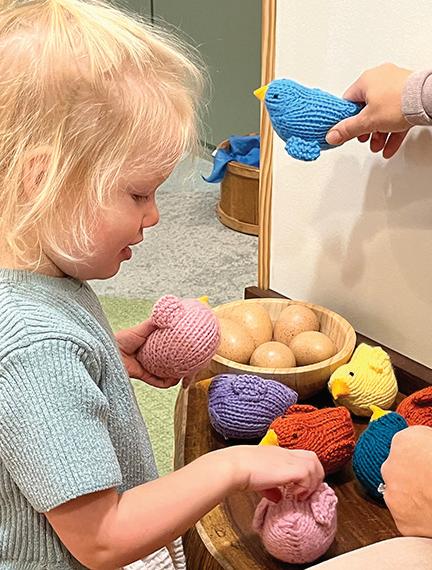
Design for Well-Being
By creating spaces that prioritize natural light, ventilation, greenery, acoustics, color, and materials, designers can create environments that promote relaxation, concentration, and creativity. Furthermore, designing spaces that encourage physical activity, social interaction, and healthy eating habits can support overall well-being and lead to healthier, happier communities.
The ability to capture hearts and minds is key to eliciting powerful emotions. Experiences that allow individuals to connect in new and meaningful ways can inspire us to feel, behave, and think differently. Design can evoke emotions by signaling permission to experience something positive and new, or provide guardrails and guidance that can be springboards to adventure, freedom, and exhilaration. Many of the most effective and innovative experiences are successful precisely because they tap into the most basic human emotions.
—Experience Reigns, Gensler Research Institute
Conclusion
As Kidzu begins to explore the possibility of relocation, the question of how to scale these lessons to an entire museum remains. Grounded in the Reggio Emilia philosophy, a 21st-century, post-pandemic children’s museum would communicate respect for learners of all ages through its design choices and orientation to community’s needs, actively listening to all voices, especially those that are often ignored. From this position, we can design a museum that is accessible and engaging for visitors from infancy through adulthood. rEsourcEs
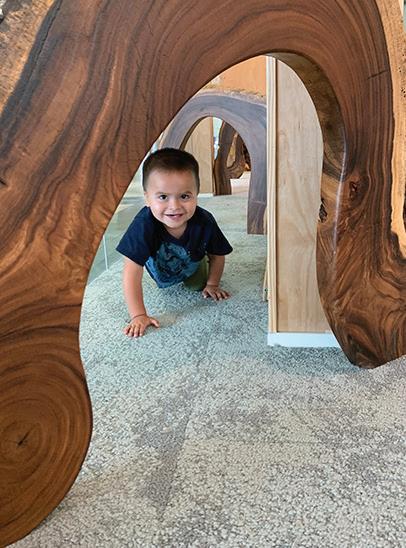
We envision a campus, organized by age and types of play and learning with quieter transition places for reflection to balance more active spaces. While the Nest is designed to promote a sense of calm and slowness, the Reggio philosophy can also be integrated easily into active spaces, like a maker space or the outdoor environment. A Reggio-inspired design and aesthetic would infuse the entire space, along with its play and learning activities. We especially want to create meaningful and much-needed spaces for tweens and teenagers that are safe, supportive, respectful, and celebratory of their unique perspectives and capabilities during this mental health crisis with dramatically rising suicide rates in this age group.
Boundaries between indoor and outdoor will be blurred to maximize interaction with the natural environment, incorporating daylight, natural ventilation, and views to the surroundings. Caring for the physical, social, and emotional wellbeing of our visitors, caregivers, children, and staff, is of utmost importance so we can raise citizens who will care for each other and their environments, no matter what the current external challenges are.
Melanie Hatz Levinson is chief creative officer and lead curator, and Samantha Shannon is the Nest coordinator at Kidzu Children’s Museum in Chapel Hill, North Carolina. Brad Burns, AIA, design director and Southeast Region Culture + Museums Practice Area leader at Gensler, is currently working with Kidzu on a conceptual master plan for the new museum.
The Nest is generously funded in part by The William R. Kenan Jr. Charitable Trust.
Carroll, Tobias. “A Growing Number of People are Attacking Art in Museums.” Inside Hook | Art (June 4, 2022).
Marshall, Alex. “How do you tell a Vandal from a Visitor? Art Museums Art Struggling.” New York Times (November 24, 2022).
Yankovich, Michael, and Gretchen Kerr, “In Search of Kindness: A Call to Action,” Hand to Hand, Volume 35, Number 2 (May 2022).
Additional Gensler Research Beyond the Senses Museum Futures
Lack of Joy is More of a Risk Than Wrestling: Looking in the Mirror
For the past seventeen years, Jill Wood has been the school librarian and founding director of an adventure playground at The Parish School in Houston, Texas. Since 1983, located on a seventeen-acre campus, The Parish School has worked with children ages two to twelve who have communication delays and learning differences, focusing on communication skills, social learning, nature, independence, and the arts.
Playworker Wood describes herself as “passionate about play and its ability to transform lives and communities.” In the Q&A that follows, fellow playworker Megan Dickerson, currently director of exhibits at the Birch Aquarium at Scripps Institution of Oceanography in LaJolla, California, talks with Wood about how the pandemic changed kids’ behavior and how the playwork approach worked to adapt existing resources to meet new needs.
DICKERSON: As you got ready to reopen Adventure Play in June 2020 after a threemonth closure, your team did a risk-benefit assessment (RBA), which requires the playworker to pause and reflect: What risks or hazards might exist in this playspace? What are the changes in personal perspective might I need to make to allow kids to take the risks they need? What were the kids like when you reopened?
WOOD: We saw very different children. They were mad and in conflict, with a lot of verbal, sometimes physical arguments. In our child-directed space, we see conflict as healthy. Children move through things quickly because we allow it, but when we reopened, they weren’t playing through stuff.
We also usually see large groups of children around the site, but we were seeing groups of two, maybe three kids max, and many who chose to be alone.
In our environment, playworkers consciously hold back so children’s culture can build, and they can feel ownership and consequences, but our typical, minimal interventions weren’t working. We had to step in more because they needed us more, and that didn’t feel like adventure play.
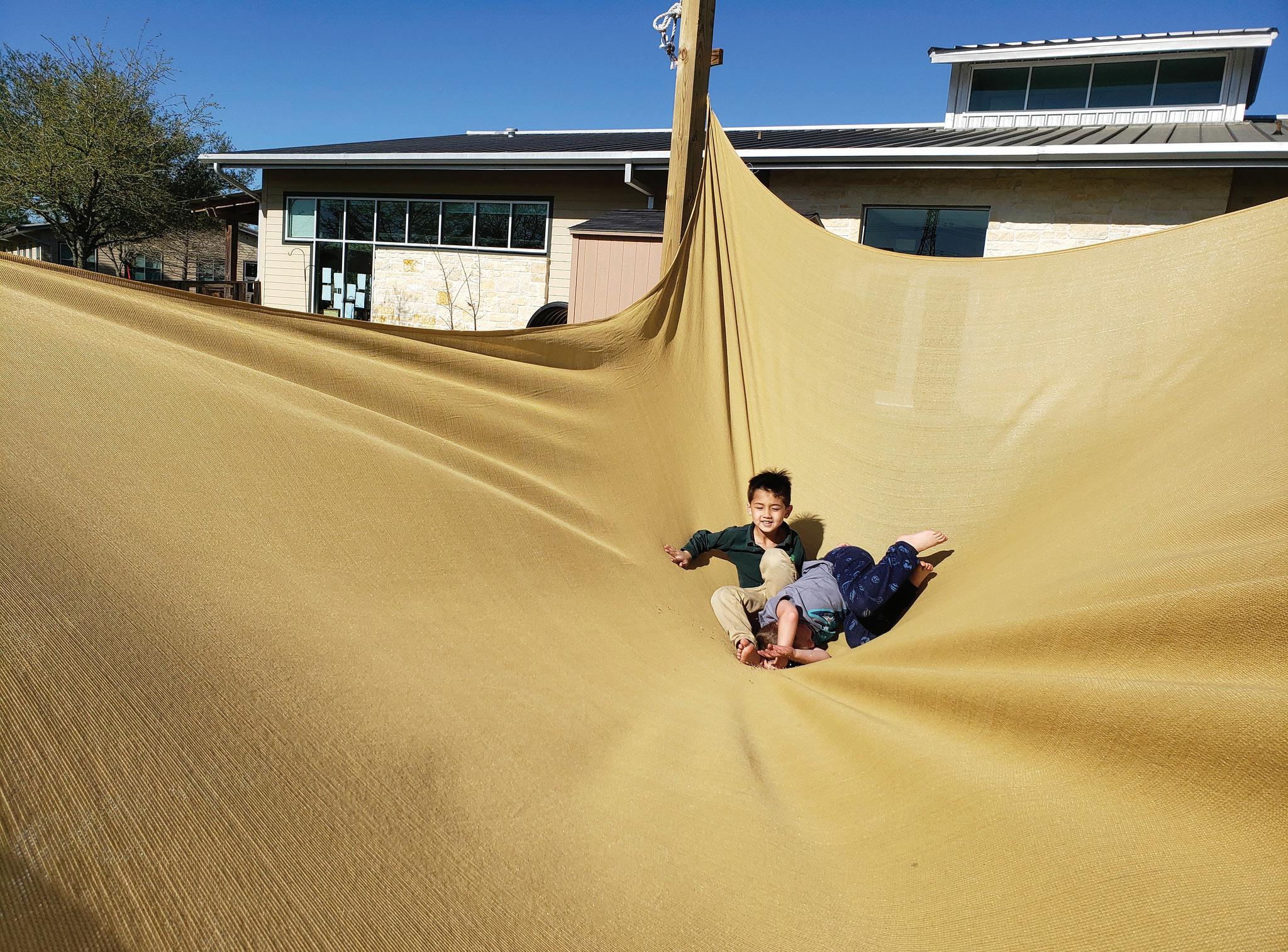
DICKERSON: It’s like the kids came back as a different species. But you were different too, right?
WOOD: Right? We were feeling anxious ourselves and then we were seeing the kids that we love and work with looking distressed. The changes were just so abrupt. Normally, change in all of our environments, whether they’re afterschool playgrounds or museums, typically happens over a long period of time. We weren’t prepared. We have since looked at our original June 2020 risk-benefit analysis for reopening, and it’s like a time capsule of ignorance. We didn’t know what we didn’t know.
DICKERSON: How did playwork tools and practices help you through this?
WOOD: I’m not gonna lie, we wanted to give up on playwork at times, because the classrooms during the school day, structured by adults, looked more peaceful. But there was always one of the playworkers on our team who would say, ‘Wait, that’s not what we do. We don’t respond to challenges by making more rules.’ A central part of playwork is observation, so we looked to see what the children were doing.
They were wrestling, which we’ve always allowed, but this was more heated, more intense. We would check in with the kids and ask, ‘Is this fun?’ And they kept saying, ‘Yes, yes, this is fun!’ So, we had to evaluate. Wrestling was not socially distanced, which was a big deal in the summer of 2020. We that with parents, which was hard to do at a time when everyone was already more anxious than usual. But advocating comes naturally to playwork. The message we try to foster in our environment is: yes, these things might be uncomfortable for you, but we’ll show you that what’s happening is really important. We had the language to do at, and we used it. you’re demonstrating that if we sit with the discomfort of “misbehavior,” and take the time to reflect on it, kids will actually show us what they need. And then we can create the playspaces that respond? felt that push/pull between what children were telling us they needed and what adults were comfortable with them doing at that time. In the end, we trusted our playwork and let it happen.
They found the tool they needed, an incredible, sensory experience and a way of releasing all the feelings they (and the adults around them) didn’t have words for. We saw giggles and things we hadn’t seen for months. That shored us up. We thought, okay, this needs to happen. This is the happiest place on our playground and we need some happy. We need some joy.
Bottom line is that we decided that the lack of joy, lack of confidence, and resulting isolation was more of a risk than the wrestling.
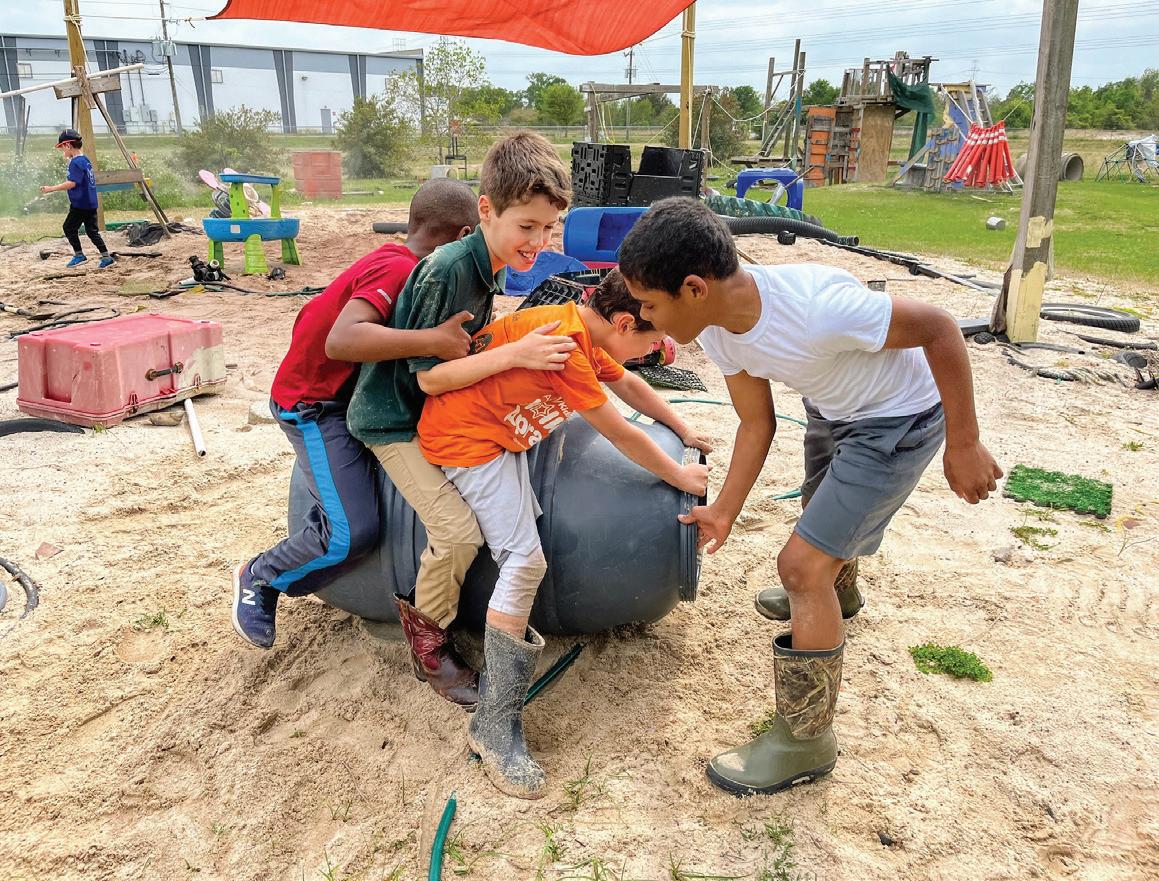
Children leaving wrestling looked a lot better than the kids who didn’t join in. It took some parent education because kids were going home with bruises and that’s not normal anymore. Yet, when I think back to when I was a kid, my shins were covered in bruises and scratches.
DICKERSON: Right, the kinds of bruises that, as a kid, you might not even have stopped for, because you were so absorbed in the play that you barely noticed it until you get home.
WOOD: Exactly. We had to normalize
We had built a second sand area, calling it the “social distancing sand pit.” In our RBA, we had limited the sand pit to eight children. We even measured it—how many kids can we fit with social distance limits? And then we built another sand enclosure far from it, thinking we could just redirect kids there, if the original one got too full. The irony was that kids weren’t in the sand pit at all at first—they were spread out everywhere. We joked that social distancing wasn’t really an issue. They didn’t want to talk to each other, and when they did, they seemed to fight. The wrestling group functioned better though. And some of them moved to what they now call The Giant Mega Hammock, which was actually the cloth we suspended over the social distancing sand pit for shade. In the Mega Hammock they did the opposite of social distancing: they wrestled.
They found the tool they needed, an incredible, sensory experience and a way of releasing all the feelings they (and the adults around them) didn’t have words for. We saw giggles and things we hadn’t seen for months. That shored us up. We thought, okay, this needs to happen. This is the happiest place on our playground and we need some happy. We need some joy.
Bottom line is that we decided that the lack of joy, lack of confidence, and resulting isolation was more of a risk than the wrestling.
DICKERSON: So many of us have reacted with “we need to create more rules because kids don’t know how to behave.” But I think
WOOD: That’s right. Our team ultimately realized that wrestling is one of the most complex forms of play there is. Think of all that needs to be communicated and understood when you are wrestling. Our children were taking that on, and they were finding solace in it.
DICKERSON: You have to challenge yourself to trust children, and not just on an adventure playground, because you’re also The Parish School librarian! What does trust look like in those two very different spaces?
WOOD: Both spaces are designed to be child-directed, so I need to keep track of and advocate for what children are actually reading. Sometimes grown-ups are uncomfortable when children check out books that are too “advanced” or materials someone has taken home a million times before, but children know what they are doing.
For instance, our comic book area is huge—almost a third the size of our nonfiction section—because I watched and noted what the students were taking home. I built up our graphic novels and we now have wait lists for them. Our students love coming to library even though many of them have learning differences that make reading very difficult. But I trust that they will tell me what they need. I just need to watch, listen, and respond. Like a playworker.
In a similar way, museums might examine their adult expectations of what they want children to be doing versus what they are doing. Observe how they are using museum spaces and follow their lead.
DICKERSON: It’s been three years since your adventure playground reopened to a whole new “species” of kid. Are you still seeing some of that changed behavior? Or did it go away with the adaptations you made?
WOOD: The Mega Hammock is just an integrated part of our site now. Sometimes they use it, sometimes they don’t. I wouldn’t say the increased anger and conflict have gone away. What has gone away is the lack of resources for the kind of play children needed. Now that we have those additional resources, the feelings and expressions of those feelings are less “disruptive” because we’ve made room for them.
DICKERSON: Creating more rules is like staring into the sun, when we need to look in the mirror.
WOOD: So true. When I’m talking to schools that want to integrate more playwork ideas or loose parts, I always tell them: you can have all the loose parts in the world, but if the adults aren’t responsive and flexible, they won’t be “loose.” Those loose parts will be tight.
DICKERSON: To stay in a place of constant learning and change—to be, as a human, the ultimate loose part– is challenging. What practices kept you going?
WOOD: Building a team and reflecting with them is key. We have protected time each week for reflection, where we help one another question and grow. The practice of holding back and letting children take the lead gets easier the more you do it, because children prove to you that they don’t need you.
We may laugh but we also know it’s not that simple. They sometimes need a hug, a bandage, a quick fix. They need us to identify safety hazards on site and hold space for their play. But in the same breath, they need us to trust them. And the more we do that, the more we realize that it works.
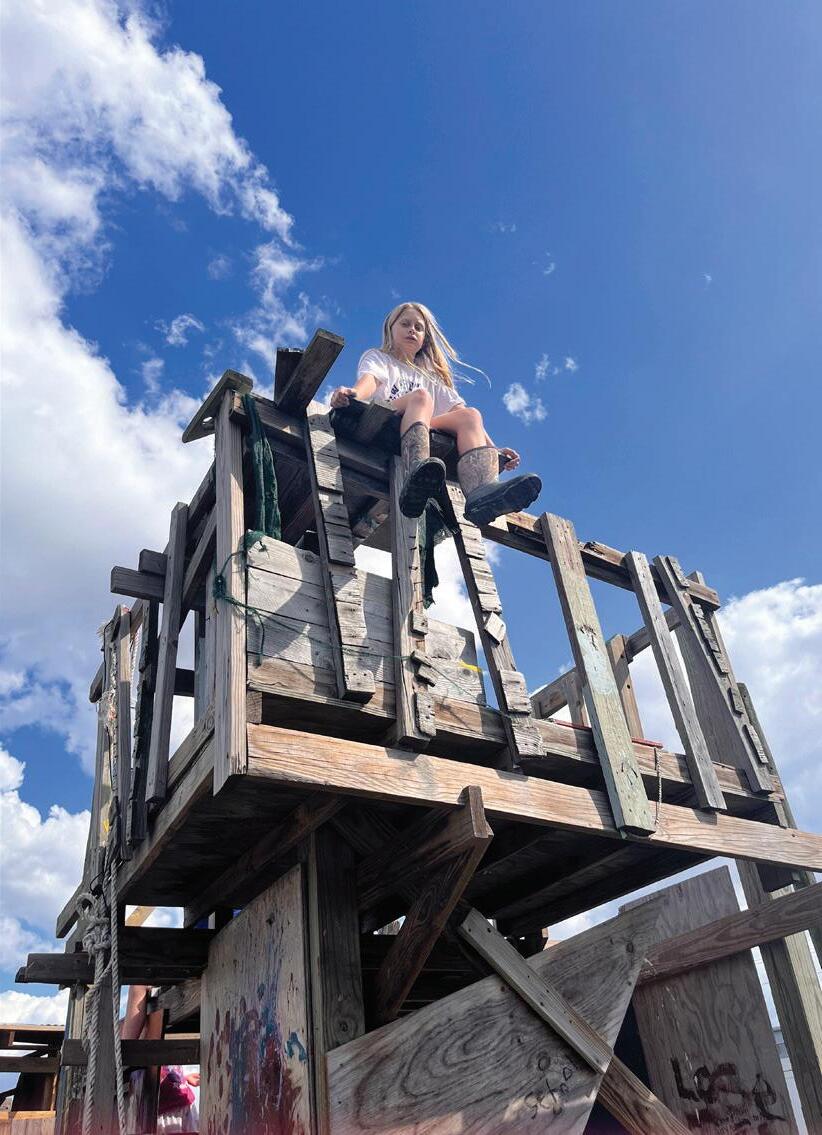
Children, and humans in general, are completely unpredictable. Something will always come up that you need your team to reflect on. Working with children is not only humbling but incredibly creative and rich. Kids will always come with new information, new ideas, new experiences, new connections that I never could have dreamt of, and that is such a gift.
And now we’ve added goats.
DICKERSON: “Adventure Playground: Now with Goats!” dents to find their voices, practice listening to others and express themselves through a group word brainstorm and an art activity. In this art and advocacy workshop, students are inspired by artists who use their artwork to share their thoughts and help advocate for their communities. The students use techniques of collage and weaving to create an expression quilt that channels their advocacy through art.
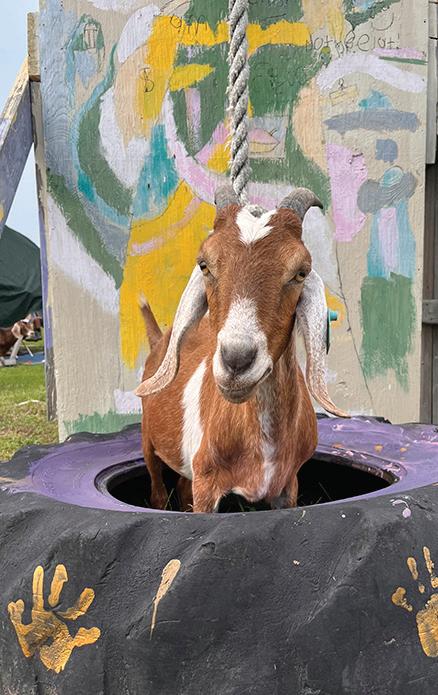
WOOD: I worked hard to get us goats, because they are funny, playful and the great equalizer. I don’t know anything about goats. The children didn’t know anything about goats. So, we’re learning together, figuring it out, and following the goats’ lead. It keeps you on your toes and keeps you from feeling too comfortable in what you think you know.
DICKERSON: That summarizes the lesson of playwork, both in 2020 and now: we can’t get too comfortable in what we think. We need to be the adults who give out bandages and look for hazards. But we’re learning as much from kids as they’re learning from us. Just try trusting kids for a little while. See what happens.
WOOD: In mid-2020, I wanted to let go of playwork. I thought “this stuff is not working, and my team is about to fall apart.” I kept looking outside of playwork to traditional classroom management, direct teaching, taking away supplies or aspects of the environment that were hot points. But living with children through pain is part of playwork too, and it’s hard. But it works.
In this program, we also bring out a prized symbol of childhood community-building: the gym class parachute. Not only does it produce giggles (a very real reason for having it in the lesson—laughter is important!), it also symbolizes working together. When one child expresses themselves by lifting the parachute, everyone else then mimics both their action and their voice, and the group sees the power of amplifying each other’s voices and actions for the good of the community.
The refocusing of the museum’s programs has also necessitated an adjustment to staff training and a re-prioritization of internal team building. We have built in more time- and depth- for educator training and have prioritized team teaching with the acknowledgment that more dynamic activities require more hands on deck. We want BCM’s educators to feel comfortable facilitating high-energy programs that reflect and draw on children’s own energy and capitalize on the informal learning environment of the museum. The Museum is a unique space in which children can make messes, and build and release the energy that they walk in with – all the while learning from it. We hope that on the best day, we are helping to facilitate the rebuilding of the muscles of constructive engagement after the difficult, isolating, and disorienting experience of the pandemic. In many ways, what visitors have shown us they are craving- through their attendance numbers, and through the positive feedback to our program offerings- has been a reminder that community-mindedness has always been at the heart of the work we do. Recent success has offered a poignant reminder that investing energy and resource in the museum community will ensure that it serves as a renewable and generative resource moving forward.
Kate Mirand Calleri is director of education and Hana Elwell is vice president of education and exhibits at the Brooklyn Children’s Museum.
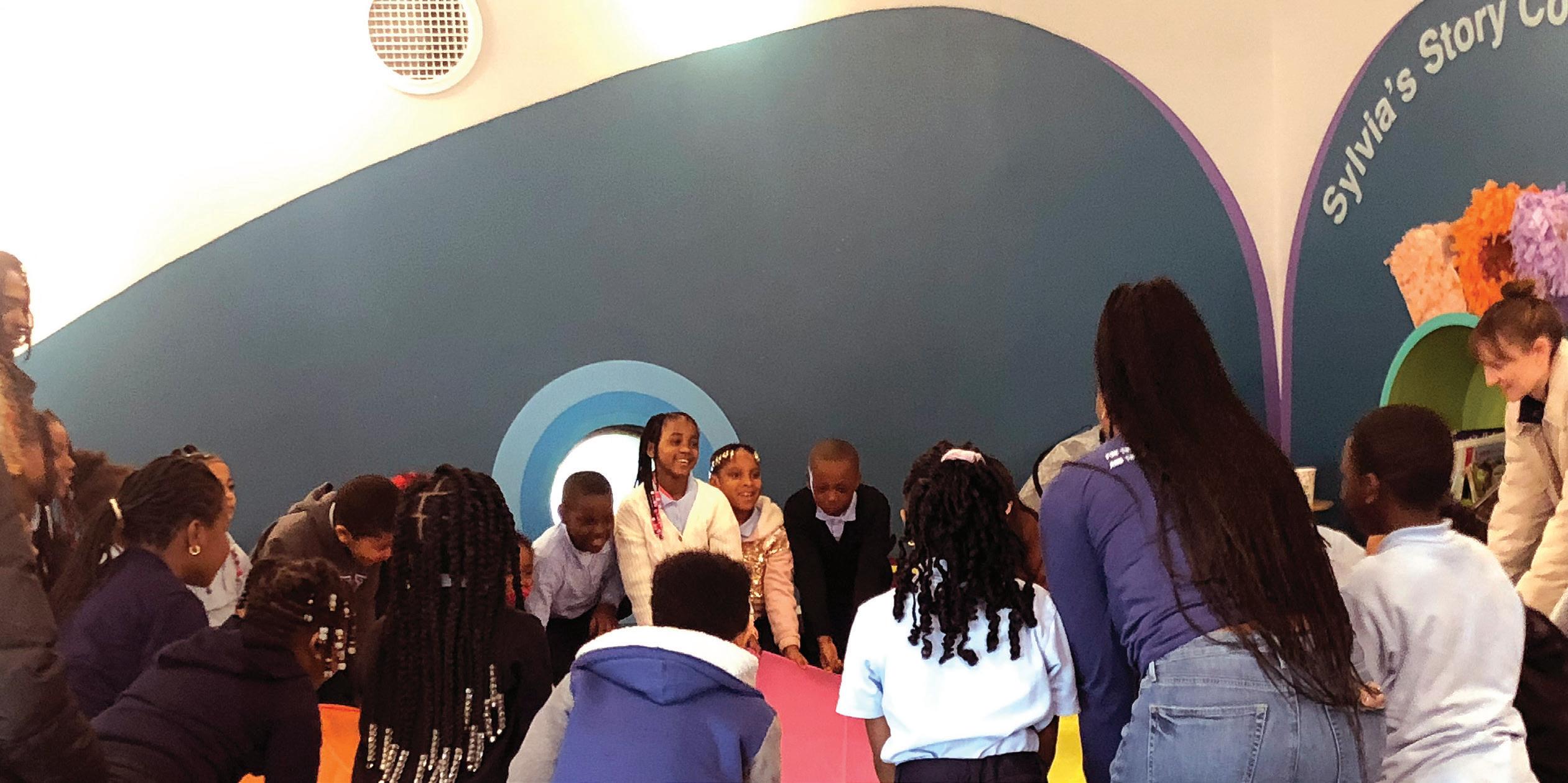
Resources
Sun J, Singletary B, Jiang H, Justice
LM, Lin TJ, Purtell KM. Child behavior problems during COVID-19: Associations with parent distress and child social-emotional skills. J Appl Dev Psychol. 2022 Jan-Feb;78:101375. doi: 10.1016/j.appdev.2021.101375. Epub 2021 Dec 14. PMID: 34924662; PMCID: PMC8668344. Child behavior problems during COVID-19: Associations with parent distress and child social-emotional skills - PMC (nih.gov)
The pandemic’s impact on children and development | News & Stories | DHMC and Clinics (dartmouth-hitchcock.org)
Arts in Schools Report 2020-2021 (nyced.org)
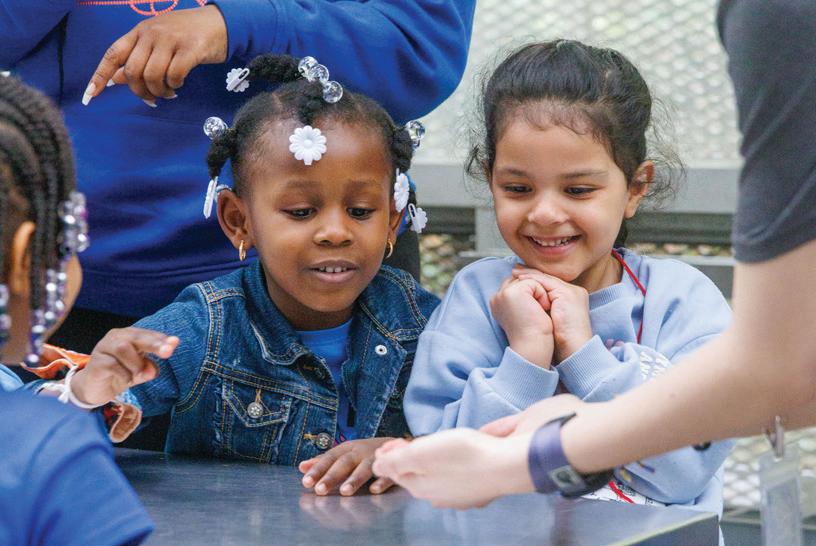
Helping Children Cope With Changes Resulting From COVID-19 (nasponline. org)
Managing the long-term effects of the pandemic on your child’s mental health | UNICEF Parenting
School art and music classes are helping kids readjust to in-person learning : NPR
Wonderscope (Kansas City, MO)
Full-time since November
2019. Previously worked with the Girl Scouts and at the Beanstalk Children’s Garden, a child-focused garden within Kansas City Community Gardens.
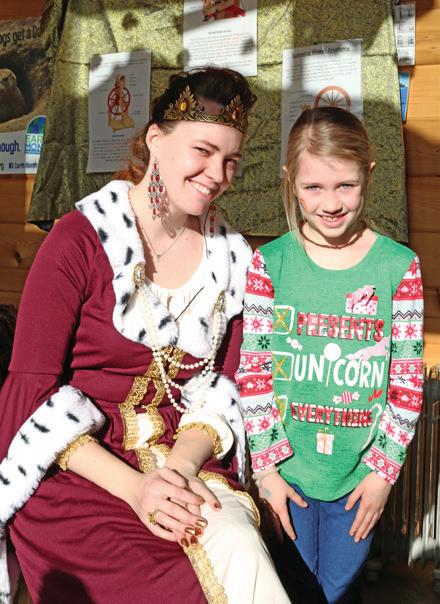
Works with guests (children and adults), and field trip students and their chaperones.


